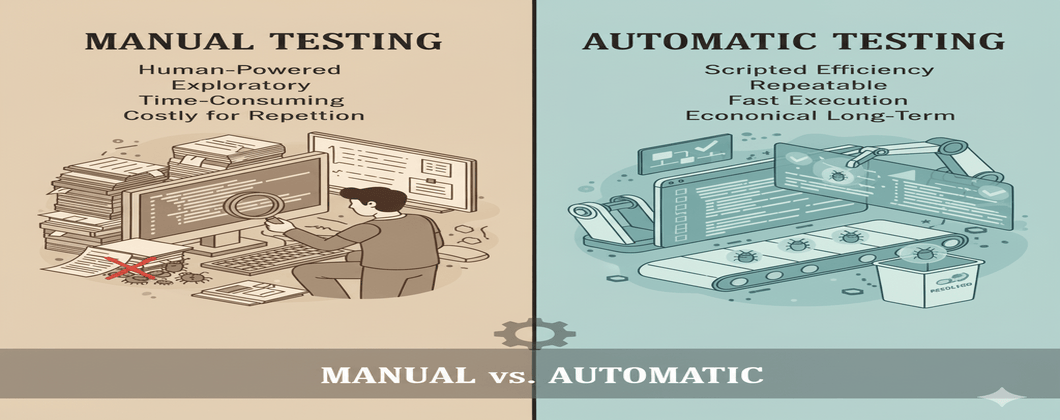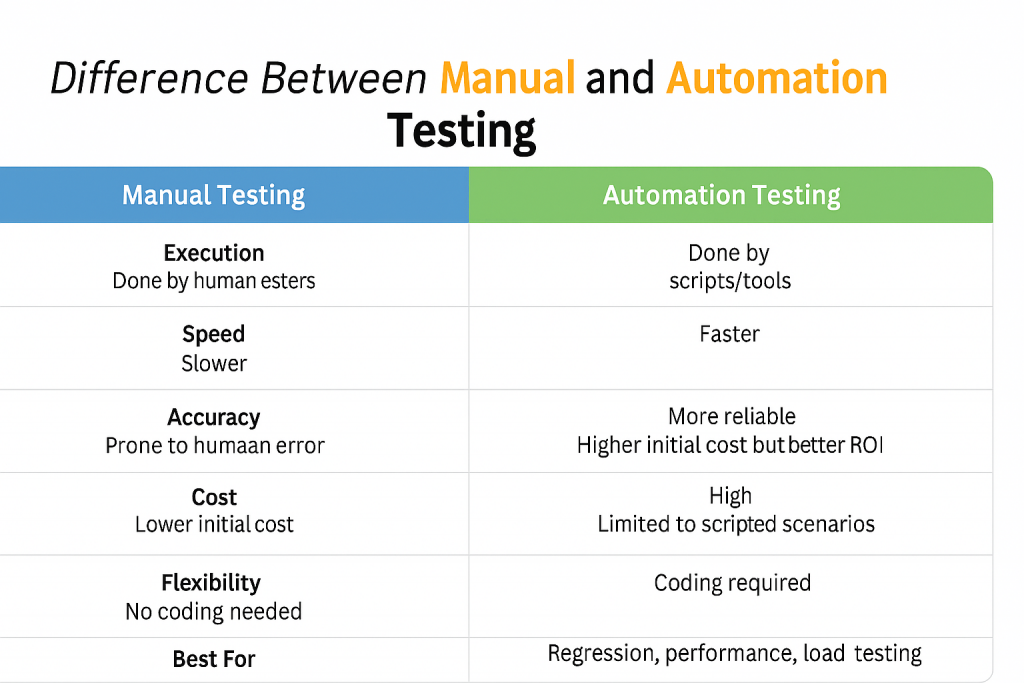
Software testing is a critical part of the development process. It ensures that applications work as expected and deliver a smooth user experience. To begin with, there are two main types of testing: manual testing and automation testing. Understanding the difference between these two approaches helps teams choose the right strategy for their projects.
In this blog post, we’ll explore the key differences, best practices, layout ideas, and career paths related to manual and automation testing. Whether you’re a beginner or a seasoned QA professional, this guide will simplify the concepts and help you make informed decisions.
What Is Manual Testing?
Manual testing is the process of checking software manually without using any automated tools. A tester performs test cases step-by-step, just like a real user would.
Key Features of Manual Testing
- No scripts or automation tools involved
- Testers interact with the application directly
- Ideal for exploratory, usability, and ad-hoc testing
- Requires human intuition and observation
Practical Example
For example, imagine testing a login page. A manual tester would enter different usernames and passwords, click the login button, and observe the results. They would note any errors or unexpected behavior.
What Is Automation Testing?
Automation testing uses scripts and tools to test software automatically. It’s faster and more reliable for repetitive tasks.
Key Features of Automation Testing
- Uses tools like Selenium, Cypress, or Playwright
- Scripts are written to perform test steps
- Ideal for regression, performance, and load testing
- Requires programming knowledge
Practical Example
Let’s say you want to test a shopping cart feature across multiple browsers. With automation, you can write a script that adds items to the cart, checks out, and verifies the total—across Chrome, Firefox, and Safari—all in minutes.
Manual vs Automation Testing: Key Differences
| Aspect | Manual Testing | Automation Testing |
|---|---|---|
| Execution | Done by human testers | Done by scripts/tools |
| Speed | Slower | Faster |
| Accuracy | Prone to human error | More reliable |
| Cost | Lower initial cost | Higher initial cost but better ROI |
| Flexibility | High | Limited to scripted scenarios |
| Skill Requirement | No coding needed | Coding required |
| Best For | Exploratory, UI, ad-hoc testing | Regression, performance, load testing |
Sources:
When to Use Manual Testing
Manual testing is useful in situations where human judgment is essential.
Ideal Scenarios
- Exploratory Testing: Discovering issues in new features
- Usability Testing: Evaluating user experience
- Visual Testing: Checking layout and design
- Short-term Projects: Avoiding setup costs for automation
When to Use Automation Testing
Automation testing shines when speed and consistency matter.
Ideal Scenarios
- Regression Testing: Repeating tests after updates
- Performance Testing: Measuring speed and scalability
- Load Testing: Simulating multiple users
- Long-term Projects: Saving time and cost over time
Best Practices for Manual Testing
To get the most out of manual testing, follow these tips:
- Write clear and concise test cases
- Use checklists to avoid missing steps
- Document bugs with screenshots and steps to reproduce
- Collaborate with developers for faster fixes
- Test across different devices and browsers
Best Practices for Automation Testing
Automation testing requires planning and discipline.
- Choose the right tools for your tech stack
- Start with stable features before automating
- Use version control for test scripts
- Schedule regular test runs
- Monitor test results and fix flaky tests
Layout Ideas for Test Documentation
Clear documentation improves team efficiency.
For Manual Testing
- Test Case ID
- Test Description
- Steps to Execute
- Expected Result
- Actual Result
- Status (Pass/Fail)
- Comments
For Automation Testing
- Script Name
- Test Scenario
- Tool Used
- Execution Time
- Logs/Reports
- Error Messages
- Environment Details
Career Path in Software Testing
Software testing offers diverse career opportunities. Whether you prefer manual or automation, there’s room to grow.
Manual Testing Career Path
- QA Analyst
- Senior QA Analyst
- QA Lead
- QA Manager
- Product Owner (with domain expertise)
Automation Testing Career Path
- Automation Tester
- SDET (Software Development Engineer in Test)
- Test Architect
- DevOps Engineer
- QA Consultant
Skills to Learn
- For Manual Testers: Test case design, bug reporting, domain knowledge
- For Automation Testers: Programming (Python, Java), tools (Selenium, Cypress), CI/CD, API testing
Suggestions for Beginners
If you’re just starting out:
- Begin with manual testing to understand the basics
- Learn how to write test cases and report bugs
- Explore automation tools gradually
- Practice with open-source projects
- Join QA communities and forums

Conclusion
To sum up, both manual and automation testing play vital roles in software development. Manual testing brings human insight, while automation testing offers speed and reliability. Choosing between them depends on your project needs, budget, and team skills.
All in all, a balanced approach often works best. Use manual testing for creative and visual checks, and automation for repetitive tasks. As a result, your software will be more robust, user-friendly, and ready for the market.
Whether you’re building a career or managing a team, understanding the difference between manual and automation testing is essential. Keep learning, stay curious, and test smarter!
For more information Contact NectorFlare
Know more about NectoreFlare Brand Click Here
To Know More About the Company, Listing NectorFlare, Click Here
People Also Searched For: Looking for a Website Designer Near Me? Here’s Why NectorFlare Is Your Best Choice
IT Companies in Delhi: Jobs & Design Tips
Angular vs React: Which One Should You Choose in 2025?
Web Developer Internship – Learn, Build, and Grow with Experts